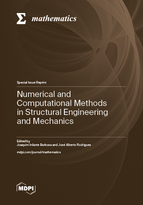Numerical and Computational Methods in Structural Engineering and Mechanics
A special issue of Mathematics (ISSN 2227-7390). This special issue belongs to the section "E2: Control Theory and Mechanics".
Deadline for manuscript submissions: closed (28 February 2025) | Viewed by 22909
Special Issue Editors
2. IDMEC, IST—Instituto de Engenharia Mecânica, Instituto Superior Técnico, Universidade de Lisboa, 1049-001 Lisboa, Portugal
Interests: structural mechanics; finite element analysis; structural optimization; composite materials; numerical computation; symbolic computation
Special Issues, Collections and Topics in MDPI journals
Interests: mathematical analysis; mathematical modeling; finite element method; isogeometric analysis; physics-informed neural networks; image processing
Special Issues, Collections and Topics in MDPI journals
Special Issue Information
Dear Colleagues,
Many complex problems arising from different areas of science and engineering can be successfully studied by applying mathematical models, demonstrating the multidisciplinary nature of mathematical modeling. In this process, a wide variety of issues are usually addressed in order to obtain robust and accurate numerical schemes.
Thus, this Special Issue aims to bring together modeling approaches that consider mathematical models, serving as a reference to existing structural engineering and mechanics problems.
The key problems addressed in this issue are also the automation and systematization of complex mechanical problems enabling significant time savings, the advantages of merging numerical and computational facets of the problems’ solving process and the development of hybrid analytical-numerical techniques. Topics of interest include (but are not limited to) the following:
- Design of robust computational methods and simulations;
- Development of parameter fitting methods and inverse problem strategies in ordinary and partial differential equations;
- Numerical simulation in structural engineering;
- Design optimization of complex structural systems;
- Computational methods in mathematics and structural engineering;
- Integrated numerical/computational methods.
Prof. Dr. Joaquim Infante Barbosa
Dr. José Alberto Rodrigues
Guest Editors
Manuscript Submission Information
Manuscripts should be submitted online at www.mdpi.com by registering and logging in to this website. Once you are registered, click here to go to the submission form. Manuscripts can be submitted until the deadline. All submissions that pass pre-check are peer-reviewed. Accepted papers will be published continuously in the journal (as soon as accepted) and will be listed together on the special issue website. Research articles, review articles as well as short communications are invited. For planned papers, a title and short abstract (about 100 words) can be sent to the Editorial Office for announcement on this website.
Submitted manuscripts should not have been published previously, nor be under consideration for publication elsewhere (except conference proceedings papers). All manuscripts are thoroughly refereed through a single-blind peer-review process. A guide for authors and other relevant information for submission of manuscripts is available on the Instructions for Authors page. Mathematics is an international peer-reviewed open access semimonthly journal published by MDPI.
Please visit the Instructions for Authors page before submitting a manuscript. The Article Processing Charge (APC) for publication in this open access journal is 2600 CHF (Swiss Francs). Submitted papers should be well formatted and use good English. Authors may use MDPI's English editing service prior to publication or during author revisions.
Keywords
- structural engineering
- mechanical problems
- fluid-structure interactions
- soil-structure interactions
- structural reliability
- mathematical modeling
- numerical schemes
- optimization
- control methods
- ordinary differential equations
- partial differential equations
Benefits of Publishing in a Special Issue
- Ease of navigation: Grouping papers by topic helps scholars navigate broad scope journals more efficiently.
- Greater discoverability: Special Issues support the reach and impact of scientific research. Articles in Special Issues are more discoverable and cited more frequently.
- Expansion of research network: Special Issues facilitate connections among authors, fostering scientific collaborations.
- External promotion: Articles in Special Issues are often promoted through the journal's social media, increasing their visibility.
- Reprint: MDPI Books provides the opportunity to republish successful Special Issues in book format, both online and in print.
Further information on MDPI's Special Issue policies can be found here.







